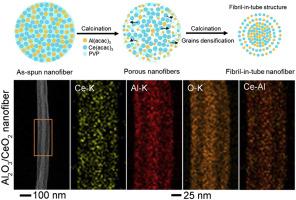当前位置:
X-MOL 学术
›
Mater. Today Chem.
›
论文详情
Our official English website, www.x-mol.net, welcomes your feedback! (Note: you will need to create a separate account there.)
Constructing fibril-in-tube structures in ultrathin CeO2-based nanofibers as the ideal support for stabilizing Pt nanoparticles
Materials Today Chemistry ( IF 7.3 ) Pub Date : 2020-09-01 , DOI: 10.1016/j.mtchem.2020.100333 S. Liu , J. Tian , K. Yin , Z. Li , X. Meng , M. Zhu , R. Seeram , Y. Sun , Y. Dai
Materials Today Chemistry ( IF 7.3 ) Pub Date : 2020-09-01 , DOI: 10.1016/j.mtchem.2020.100333 S. Liu , J. Tian , K. Yin , Z. Li , X. Meng , M. Zhu , R. Seeram , Y. Sun , Y. Dai

|
Abstract The intriguing one-dimensional (1D) nanofibers with secondary structures (e.g., hollow, core-sheath, fiber-in-tube) have attracted much attention for their unique open structure, high surface area, and hierarchical pore structure. This work utilized single-spinneret electrospinning to construct mesoporous CeO2-based ultrathin nanofibers with a new fibril-in-tube morphology. The intriguing fibril-in-tube structure within Al2O3/CeO2 nanofibers was achieved by carefully selecting two different metal precursors with different decomposition rates upon calcination. The use of Al(acac)3 as Al2O3 precursor, which rapidly releases gaseous pieces and leads to the growth kinetics varied along the radial direction of nanofibers, is critical to the formation of fibril-in-tube structure. The new CeO2 nanofibers with different amount of Al2O3 endowed with homogenous elemental distribution and were explored as reliable metal supports toward stabilizing Pt nanoparticles under harsh aging. This inspiring result was ascribed to an energy barrier established by reducible (CeO2) and non-reducible oxide (Al2O3), strong metal-support interaction between Pt and CeO2, as well as the physical confinement caused by the fibril-in-tube structure. The resultant new catalytic system (referred to Pt@Al2O3/CeO2) displayed good sinter-resistant performance and exhibited 13-times great catalytic activity than that of Pt@Al2O3 catalyst after harsh aging at 700 °C toward the hydrogenation of p-nitrophenol.
中文翻译:

在超薄 CeO2 基纳米纤维中构建管内原纤维结构作为稳定 Pt 纳米颗粒的理想载体
摘要 具有二级结构(如空心、芯鞘、管内纤维)的迷人一维(1D)纳米纤维因其独特的开放结构、高表面积和分级孔结构而备受关注。这项工作利用单喷丝头静电纺丝技术构建了具有新型管内原纤维形态的介孔 CeO2 基超薄纳米纤维。Al2O3/CeO2 纳米纤维中有趣的管内原纤维结构是通过仔细选择两种不同的金属前体在煅烧时具有不同的分解速率来实现的。使用 Al(acac)3 作为 Al2O3 前驱体,可快速释放气态碎片并导致沿纳米纤维径向变化的生长动力学,对于管内原纤维结构的形成至关重要。具有不同 Al2O3 含量的新型 CeO2 纳米纤维具有均匀的元素分布,并被探索作为可靠的金属载体,在严酷老化下稳定 Pt 纳米粒子。这一鼓舞人心的结果归因于由可还原 (CeO2) 和不可还原氧化物 (Al2O3) 建立的能垒、Pt 和 CeO2 之间的强金属-载体相互作用以及由原纤维管结构引起的物理限制。所得的新型催化体系(称为 Pt@Al2O3/CeO2)在对硝基苯酚的加氢反应中在 700°C 剧烈老化后表现出良好的耐烧结性能,并且表现出比 Pt@Al2O3 催化剂高 13 倍的催化活性。这一鼓舞人心的结果归因于由可还原 (CeO2) 和不可还原氧化物 (Al2O3) 建立的能垒、Pt 和 CeO2 之间的强金属-载体相互作用以及由原纤维管结构引起的物理限制。所得的新型催化体系(称为 Pt@Al2O3/CeO2)在对硝基苯酚的加氢反应中在 700°C 剧烈老化后表现出良好的耐烧结性能,并且表现出比 Pt@Al2O3 催化剂高 13 倍的催化活性。这一鼓舞人心的结果归因于由可还原 (CeO2) 和不可还原氧化物 (Al2O3) 建立的能量势垒、Pt 和 CeO2 之间的强金属-载体相互作用以及由原纤维管结构引起的物理限制。所得的新型催化体系(称为 Pt@Al2O3/CeO2)在对硝基苯酚的加氢反应中在 700°C 剧烈老化后表现出良好的耐烧结性能,并且表现出比 Pt@Al2O3 催化剂高 13 倍的催化活性。
更新日期:2020-09-01
中文翻译:

在超薄 CeO2 基纳米纤维中构建管内原纤维结构作为稳定 Pt 纳米颗粒的理想载体
摘要 具有二级结构(如空心、芯鞘、管内纤维)的迷人一维(1D)纳米纤维因其独特的开放结构、高表面积和分级孔结构而备受关注。这项工作利用单喷丝头静电纺丝技术构建了具有新型管内原纤维形态的介孔 CeO2 基超薄纳米纤维。Al2O3/CeO2 纳米纤维中有趣的管内原纤维结构是通过仔细选择两种不同的金属前体在煅烧时具有不同的分解速率来实现的。使用 Al(acac)3 作为 Al2O3 前驱体,可快速释放气态碎片并导致沿纳米纤维径向变化的生长动力学,对于管内原纤维结构的形成至关重要。具有不同 Al2O3 含量的新型 CeO2 纳米纤维具有均匀的元素分布,并被探索作为可靠的金属载体,在严酷老化下稳定 Pt 纳米粒子。这一鼓舞人心的结果归因于由可还原 (CeO2) 和不可还原氧化物 (Al2O3) 建立的能垒、Pt 和 CeO2 之间的强金属-载体相互作用以及由原纤维管结构引起的物理限制。所得的新型催化体系(称为 Pt@Al2O3/CeO2)在对硝基苯酚的加氢反应中在 700°C 剧烈老化后表现出良好的耐烧结性能,并且表现出比 Pt@Al2O3 催化剂高 13 倍的催化活性。这一鼓舞人心的结果归因于由可还原 (CeO2) 和不可还原氧化物 (Al2O3) 建立的能垒、Pt 和 CeO2 之间的强金属-载体相互作用以及由原纤维管结构引起的物理限制。所得的新型催化体系(称为 Pt@Al2O3/CeO2)在对硝基苯酚的加氢反应中在 700°C 剧烈老化后表现出良好的耐烧结性能,并且表现出比 Pt@Al2O3 催化剂高 13 倍的催化活性。这一鼓舞人心的结果归因于由可还原 (CeO2) 和不可还原氧化物 (Al2O3) 建立的能量势垒、Pt 和 CeO2 之间的强金属-载体相互作用以及由原纤维管结构引起的物理限制。所得的新型催化体系(称为 Pt@Al2O3/CeO2)在对硝基苯酚的加氢反应中在 700°C 剧烈老化后表现出良好的耐烧结性能,并且表现出比 Pt@Al2O3 催化剂高 13 倍的催化活性。



























 京公网安备 11010802027423号
京公网安备 11010802027423号